Review: 20-plus courses. 10 seats. Insanity. At Somni, it’s all a dream
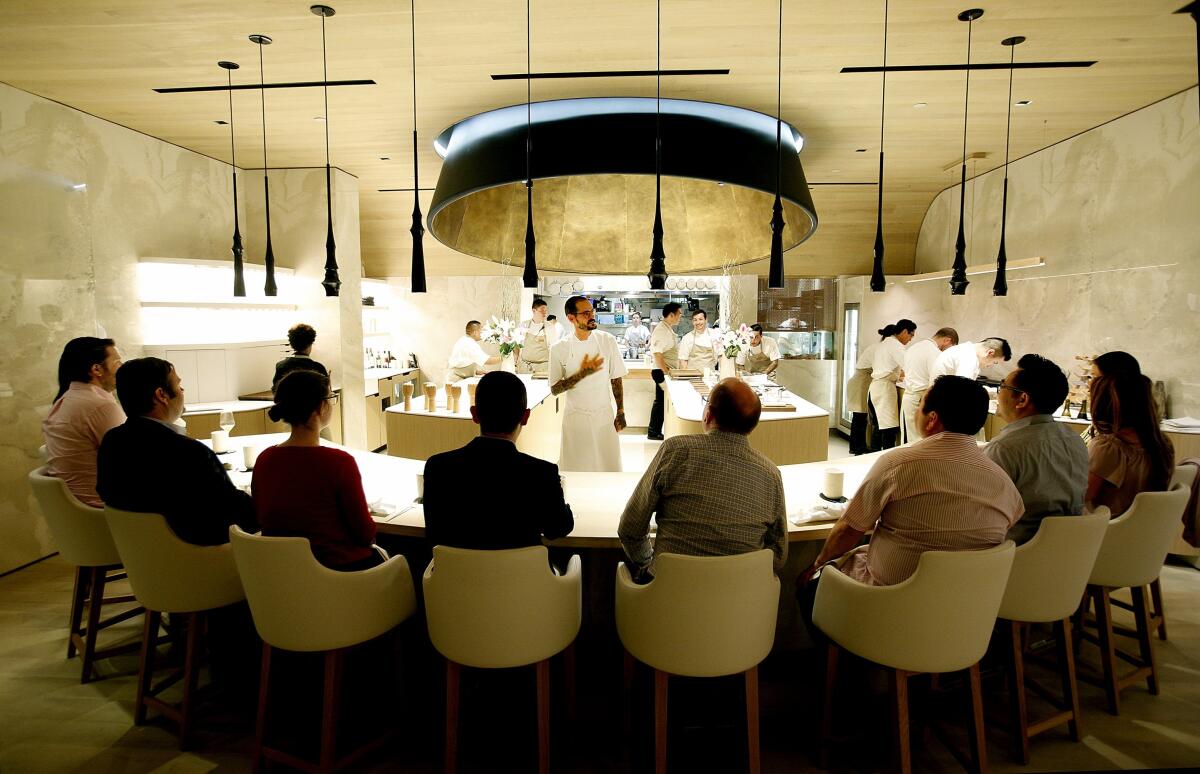
It’s time for the 17th course to be served at Somni. Seven cooks line up along a marble kitchen counter as spotless as their fitted chefs’ whites. They fan out, delivering cut-glass plates to each of the 10 diners seated in a row in front of them. Set on the center of a square linen napkin is a hunk of yellowfin tuna, flesh still joined to fin, carved in the shape of a hatchet. It looks like an edible rendering of some elaborate Bond weapon out of the ’60s, dangerous and delicious.
“Tuna katsu, fried in brioche crumbs,” a staffer announces. Others spoon saffron-scented sauce speckled with caviar over the fish. Chef Aitor Zabala trails his crew, explaining to diners that he’s used a rich, often overlooked cut of tuna called parpatana in Spanish, excised from right below its jaw.
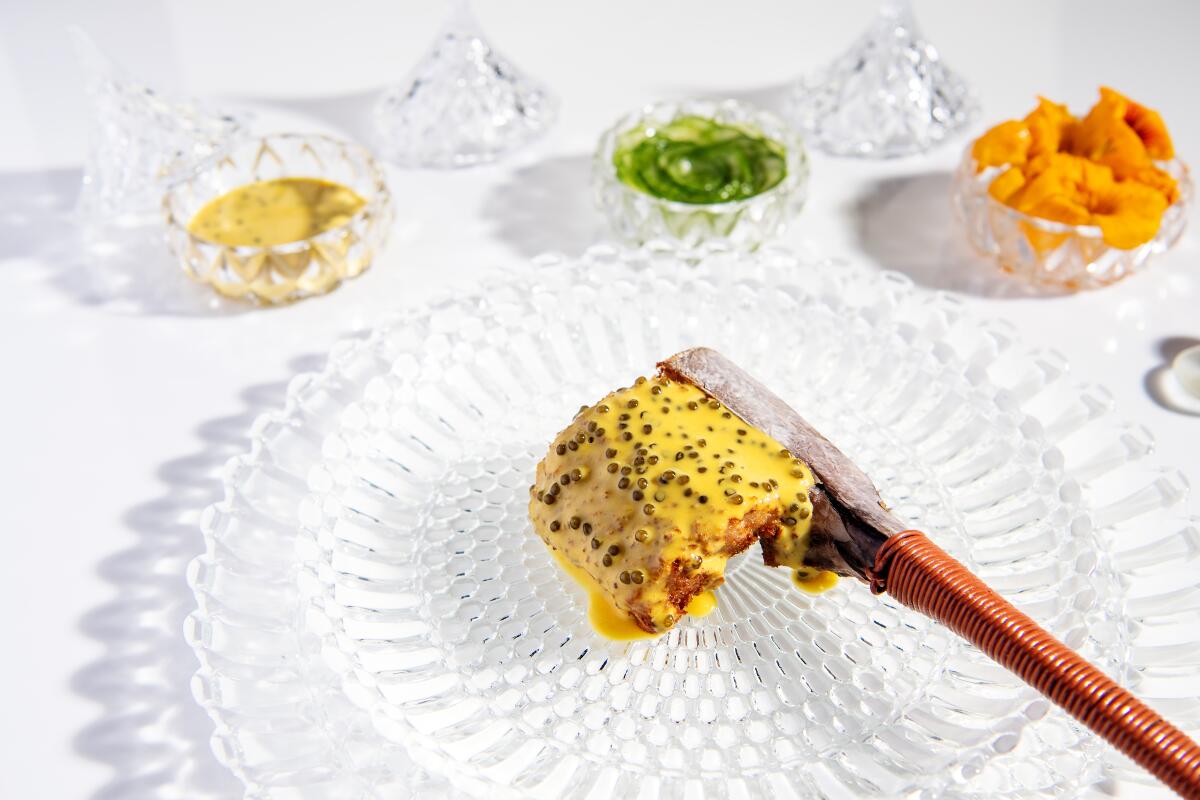
We pick up the sea-ax by its spindly handle, with plastic twine wound around it as a grip. The coating crunches. The caviar bursts. The tuna all but melts. Same for its devourer.
The beautiful tableware disappears and a sommelier swoops in to pour the next rounds of rare vintages. The corps of cooks are now bent over undulating planks of wood, arranging pigtail curry buns paired with a pool of yolk-colored Thai curry. The 18th course is on its way.
Welcome to the headiest heights of luxury dining, hidden in the ground-floor warrens of the SLS Beverly Hills. Somni — a tiny flight of fancy where dinner, before beverages, costs $280 per person — is concealed within the postmodern trappings of tapas-focused Bazaar. José Andrés owns both restaurants; they’re among the nearly two dozen businesses he operates across the country.
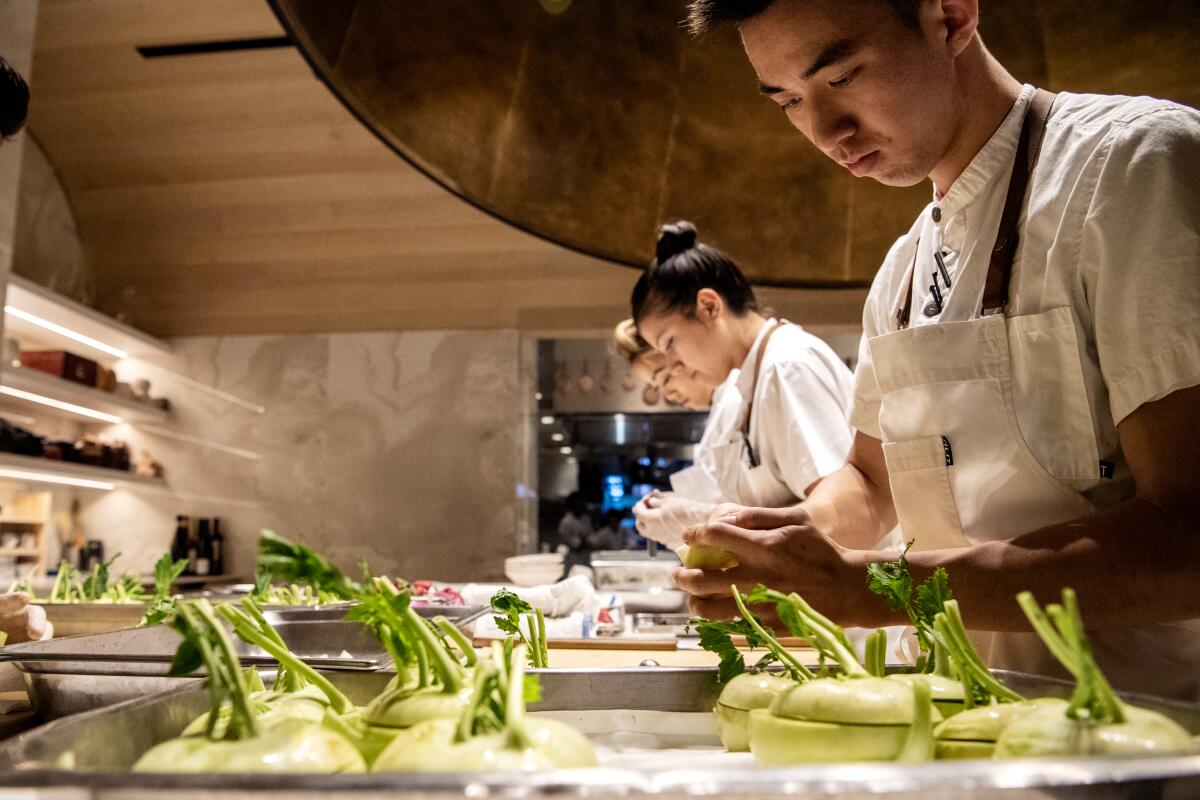
Bazaar was a modernist sensation when it opened in 2008. S. Irene Virbila, then The Times’ restaurant critic, gave the restaurant a rare four-star review. The reverse-spherification olives and margarita with “salt air” foam seem much less fantastical than they did a decade ago; down-to-earth Spanish dishes like scallops with romesco and croquetas de pollo remain highlights. Somni sprang to life last year as a replacement for 8-year-old Saam, a less intimate, 40-seat version of the same haute sanctum.
Zabala ran Saam and conceived Somni with Andrés. Its hidden setting, experimental cooking and counter-side tasting menu motif mirrors Andrés’ two other top-flight restaurants, Minibar in D.C. and é in Las Vegas. I’ve dined at each of them, and Somni is the best of the three — the one most creatively supercharged yet grounded in profound pleasure, the one that moves notions of engaged hospitality forward, the one most worth the considerable splurge.
The name, Catalan for “dream,” is apt. Walk into the unmarked dining room, just past the pink tile and ironic candelabra of Bazaar’s dessert bar, and it can feel as if you’ve stumbled into a mastermind’s subconscious. Few straight lines delineate the space; things feel slightly out of proportion, like a funhouse. The oak-lined ceiling curves toward the kitchen, which sits directly in view but also feels entirely out of reach. Artist Okuda San Miguel’s rainbow-tinted, geometric animal heads hang on the wall. They’re hunting trophies from dead-of-night narratives that fade from memory as you start your day, and yet they’ve crossed over.
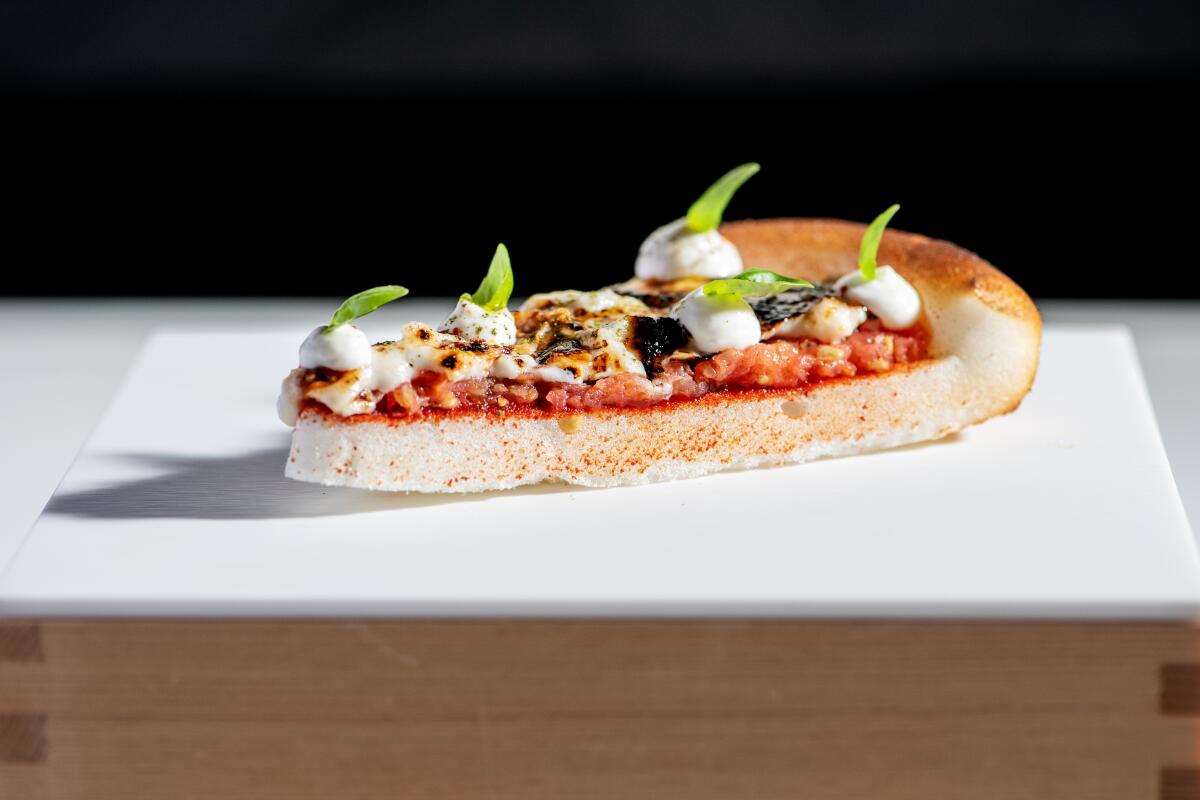
Pendant lights dangle directly over each of the restaurant’s 10 counter seats. A spotlight shines on every diner. No fourth wall exists here. The Somni experience is a tightly scripted, directed and choreographed performance; an acting coach trained the opening team. Every course — and there are 20-plus of them, none larger than four bites — starts with a short monologue from a chef, introducing each dish and often including instructions. Close-up chats with Zabala and other staff follow; they might exhibit a whole dry-aged turbot, or identify a mysterious green powder as pulverized oregano.
(Speaking of dinner as theater: Ticketed reservations are slotted for 5:45 and 8:45 p.m. Tuesday through Saturday, and they’re hell to score, particularly after Somni received two stars in Michelin’s California guide in June. Be ready when bookings go live the first Monday of every month at 10 a.m.)
Dishes evolve steadily but the meal’s structure has been consistent since Somni opened. Dinner begins with snacks: wispy potato chips shaped like butterflies with an oniony dip; almond shells with molten centers. A frozen margarita-guacamole hybrid combines avocado, tequila and habanero liqueur; the mixture is chilled in liquid nitrogen and smeared on wide pestle sticking out of a stone mortar.
An early dazzler resembles a triangular slice of pizza: The “crust” is made from powdered egg whites and clarified tomato liquid whipped into a savory meringue, crowned with dollops of mozzarella mousse and basil leaves (and, if you opt for the $75-$110 up-charge, shaved truffles). The brain recognizes the familiar form and the tomato-cheese-basil trinity, but the textures disarmingly toy with our preconceptions.
Perhaps Somni’s style might best be described as Notional Cuisine. It blurs the line between whimsy and academia, between applied theory and cheeky cleverness. Zabala doesn’t much like labels applied to his cooking. Chefs from the school of molecular gastronomy tend to feel this way. He’s a native of Barcelona and an alum of Ferran Adrià ’s now-closed El Bulli. Many of Zabala’s creations build upon, or comment on, Adrià ’s repertoire and classics from culinary lexicons around the world. His great, timely gift is in creating cerebral menus that also happen to deeply satisfy appetites and emotions.

Sometimes obvious indulgences arrive. A small ceramic vessel, concave at the top, holds a layer of tuna tartare with smoked bone marrow and a stratum of caviar. A cook pours over a vinegary liquid described as “chicken escabeche” that at once enriches and brightens the many dense flavors. Shiso leaf battered in greaseless tempura models sterling technique; borage leaves arrayed over top shroud a lush mound of dry-aged beef tartare.
Some moments are strictly playful. Mid-meal the “strawberry Negroni” appears, a Trojan horse of a berry forged from cocoa butter and hiding Aperol, strawberry purée and vermouth. Chomp; gush.
A cheese course comes with a cracker whose shape alerts us to the animal from which the milk came. I break a cow in half, and then look over my shoulder to see if San Miguel’s colorful beasts have their eyes on me.
Zabala reaches the purest happiness zones with savory dishes that reinterpret sweet pastries. Panellets, almond marzipan treats from Catalonia often crusted with pine nuts, receive the trompe l’oeil treatment and arrive as spheres of Manchego rolled in puffed rice. Sheets of crisped chicken skin slicked with bacon cream imitate the crackle of mille-feuille. He takes ensaïmada, Mallorcan sugar-dusted puffs of lard-enriched pastry, as inspiration and renders them in brioche filled with caramelized onions, matsutake mushrooms and a gloss of the signature lard. These all engender contentment, and they ensure you leave full.
I love when Zabala gets his hands on Santa Barbara spot prawns; he serves them unadorned and cooked to a precise snap. It’s a reprieve from the pyrotechnics, and it puts the wizardry that comes before and after into sharp relief.
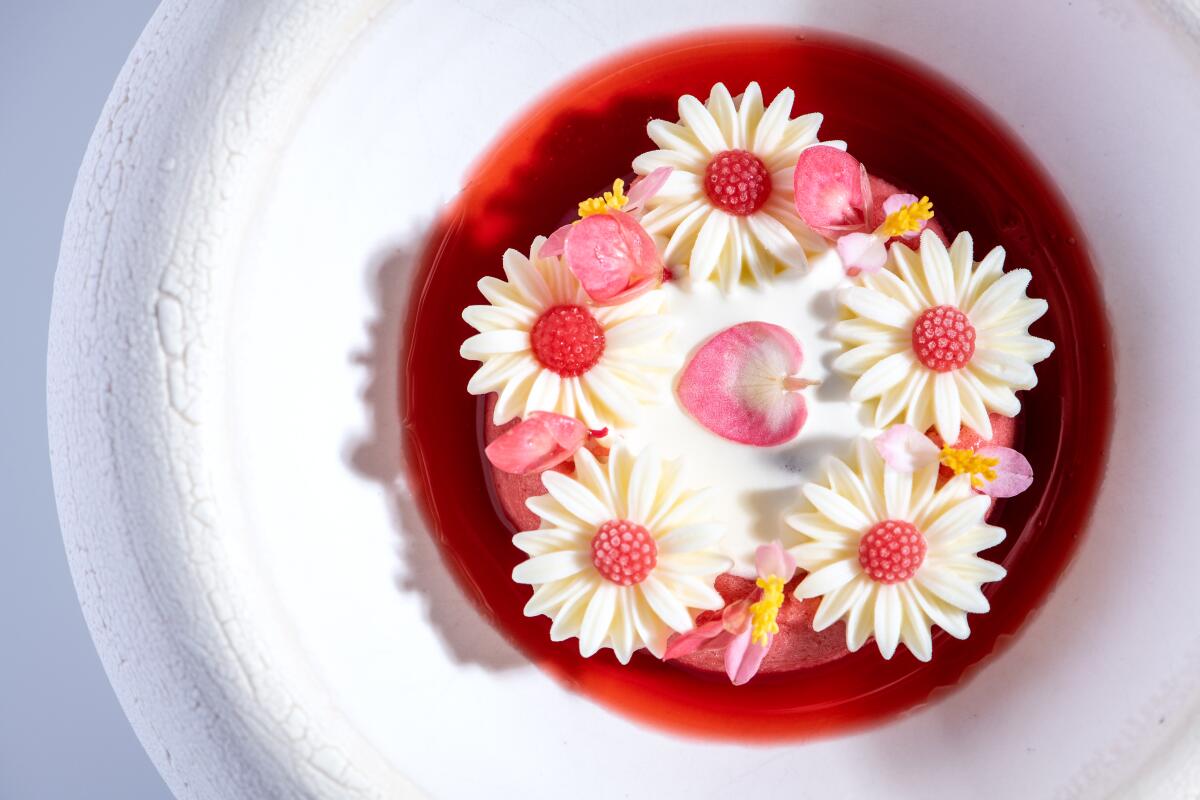
The prawns appear as they’re available. Trophy ingredients can rotate into action — white asparagus, various shades of freshly dug truffles — but the restaurant eschews emphatic seasonality. It’s the radical genius of Somni: Andrés and Zabala defy all the usual rules about transplant fancy chefs who can succeed only by conforming to Southern California’s notions of freshness and abundance. The ingredients are impeccable, but the meal doesn’t convey a provenance that points to any place but the imagination.
Certainly, this kind of restaurant caters to the moneyed, food-obsessed elite; it stretches notions around art and craft and theater like taffy. It’s also proof that unruly creativity can thrive on every level in Los Angeles dining.
Somni has few local peers in price and bleeding-edge originality: Niki Nakayama’s n/naka, Dave Beran’s Dialogue, Brandon Go’s Hayato, Michael Cimarusti’s Providence, Jordan Kahn’s Vespertine. At each of them, one way or another, you know your place on the world’s map. At Somni, you drift out sated and unsure. It’s not until you’re past Bazaar’s Mad Hatter decor, pulled away from the hotel’s generic carport and in sight of the Beverly Center that you rouse from the waking dream, entirely sure now of exactly where you are.
Somni
Location: SLS Beverly Hills, 465 La Cienega Blvd., (310) 246-5543, exploretock.com/somni/
Prices: Dinner $280 per person. Wine pairings in three tiers: $185, $250 and $500. Non-alcoholic pairings $85.
Details: Credit cards accepted. Wine and beer. Lot and street parking. Wheelchair accessible.
Recommended dishes: Somni serves a modernist set tasting menu. Be ready for an adventure.
More to Read
Eat your way across L.A.
Get our weekly Tasting Notes newsletter for reviews, news and more.
You may occasionally receive promotional content from the Los Angeles Times.










